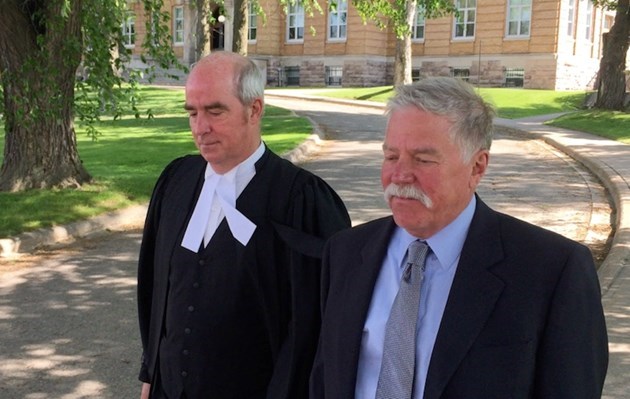Defence lawyer Robert MacRae questioned Tuesday how it is possible to find the actions of former engineer Robert Wood in 2009 and 2012 caused the tragic deaths of two women in the Algo Centre Mall collapse.
The Crown has not proven causation beyond a reasonable doubt, he said in his closing submission, arguing the cause began 32 years before the fatal June 23, 2012 collapse of the Elliot Lake facility.
Wood inspected the mall in 2009 and in April 2012, declaring it structurally sound just weeks before the rooftop parking deck caved in, killing Doloris Perrizzolo, 74, and Lucie Aylwin, 37, and injuring more than a dozen people.
He has pleaded not guilty to two counts of criminal negligence causing death and a single count of criminal negligence causing bodily harm.
Family members of the two victims returned to the Sault Ste. Marie courtroom this week to hear the Crown and defence closing arguments as the five-month trial that began in early September draws to an end.
Problems in the mall began at the design stage, with two key shortcomings — the placement of a parking lot on top of the mall, and without sound waterproofing, MacRae maintained.
The next error came in 1980 with the selection of the waterproofing system, he said.
Algocen Realty, the mall's initial owner, failed to stop the leaks or repair the roof before selling it to Elliot Lake Retirement Living, which later sold the facility to Robert Nazarian (in 2005), MacRae said.
When he hired Wood to do the inspections, Nazarian didn't reveal that the mall had leaked from the day it opened, something he knew because he had received a $2-million discount for "purchasing the mall as is," the defence lawyer stated.
Nazarian purposely concealed a lot of information about the mall to anyone he came into contact with and "stands alone" in deceit, MacRae told Superior Court Justice Edward Gareau.
The mall owner knew a 1996 order hadn't been complied with when he bought the mall, and didn't pass that information on to Wood, he said.
MacRae called it "shocking how many engineers and architects were in that mall from the time it was built and how much of that information was not made available to each inspector."
"The clean bill of health given by a number of experts before the collapse is quite alarming," he said, indicating none of these engineers, inspectors and architects provided a report "extensively different" than Wood's 2012 report.
Wood "had no reason to believe the building had leaked for 32 years," he argued.
Wood testified that Nazarian hadn't told him that a structural component had failed in 2011, the defence lawyer said, stating Nazarian knew that concrete had fallen from the core slabs.
Referring to Nazarian's testimony, MacRae said the mall owner had acknowledged that Wood should have been informed of the falling concrete, but lied to the court by saying he provided information and photographs to Wood.
Nazarian wants the court to believe Wood was aware of the structural problems and falling concrete and he wasn't, MacRae said.
An expert, who testified at the trial about a forensic investigation his company prepared for police following the cave-in, indicated that the collapse was in the making for years and was surprised it hadn't happened earlier, MacRae said.
Dr. Hassan Safarini also indicated in the report that he found it perplexing that the roof was allowed to leak for 32 years.
The court heard that this was the first carbon steel building, of 30-plus years, that had collapsed or failed in North America or Europe.
This report, outlining that a steel building with leaking will collapse suddenly and cause horrible consequences like those in Elliot Lake, will be required reading in every engineering school in Ontario, Canada, North America and Europe, MacRae said.
He noted experts indicated building structural engineers were not typically acquainted with failure due to corrosion because there had been no other case.
Occupied buildings are assumed to be kept in dry condition and not subject to corrosion, he told the court.
What happened in Elliot Lake "was so striking that the premier of Ontario called a commission of inquiry in response to the collapse and the response to the response to the collapse," he said.
MacRae argued that Wood's conduct in examining the mall and the reports he prepared didn't meet the high threshold of wanton, reckless disregard.
His client conducted the inspection with overall regard to safety, he said.
The defence will continue his closing submission today and when he completes his case, the Crown will make its arguments.




